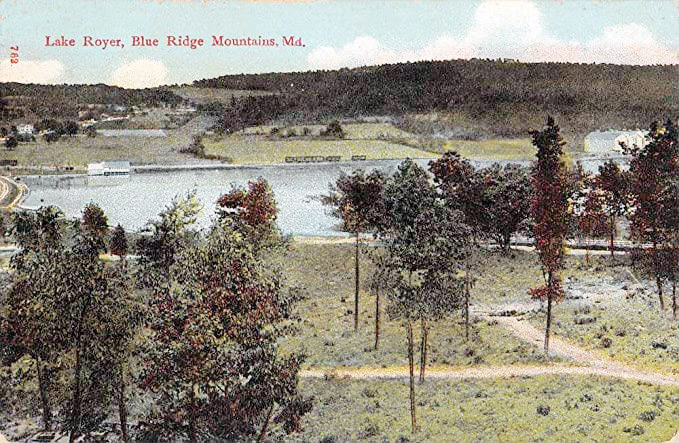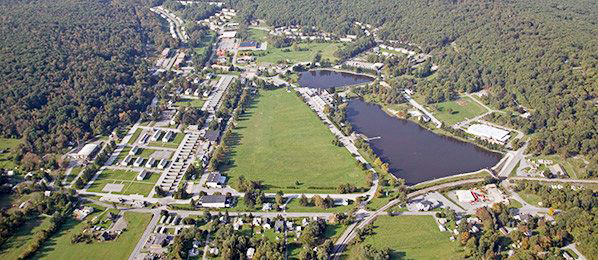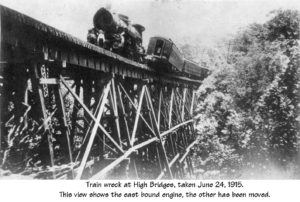The Mountain Seaside
by James Rada, Jr.
It was supposed to be a Maryland seashore on a mountaintop.
In 1889, the Buena Vista Ice Company bought 400 acres of land where Fort Ritchie would eventually be built, and set aside 20 acres for a lake.
“The business had counterparts on the East Coast below the Mason-Dixon Line,” according to the Hagerstown Morning Herald.
Perhaps forgetting that the purpose of the lake was to freeze in the winter, so the ice could be cut into blocks and sold, people were more interested in its summertime uses. They began picturing the area as the next Ocean City.
The Catoctin Clarion reported in August 1901, shortly after Lake Royer opened, “They now have a miniature ‘shore’ up on top of the mountain: by feeding at proper intervals, several barrels of fish salt into the stream that feeds the ‘lake,’ sea water may be imitated; by hiring a small boy to teeter a log in the water, modest breakers may be fashioned; high and low tides may be accomplished by lowering into and hoisting from the lake kegs of nails, twice in every twenty-four hours; the rattles taken from the rattlesnake skins that the mountain belles are wearing for belts, might be scattered about the beach to represent sea shells…”
The writer envisioned Blue Ridge Summit becoming the ultimate summer destination. Of course, Pen-Mar was already a popular summer getaway, and the lake would only cement its reputation.
“Lake Royer is a lovely sheet of water, covering about 21 acres, and is located near Buena Vista Station, and within easy reach of Pen-Mar, Blue Ridge, Monterey and Blue Mountain,” the Frederick News reported.
Col. John Mifflin Hood, president of the Western Maryland Railway, created Pen-Mar Park in August 1877 as a way to attract people to use the railroad to get out of the heat of the city during the summer. The park offered a view of over 2,000 square miles and two mountain ranges at an altitude of 1,400 feet. It is located on the border between Maryland and Pennsylvania, hence the name.
“From here on a clear day, one could see the town clock in Chambersburg, Pennsylvania, at a distance of 24 miles—with binoculars, of course,” Frank and Suanne Woodring wrote in the book, Images of America: Pen-Mar.
Pen-Mar Park featured a dancing pavilion and a dining room that could seat 450 people. An observation tower was added in 1878. Lake Royer’s opening in 1901 allowed the park to offer one more attraction.
Trains heading to Blue Ridge Summit left Baltimore daily at 9:15 a.m. and advertised the new lake. Tickets cost $1, plus an extra 50 cents if you wanted to eat dinner at Pen-Mar.
“The popularity of Lake Royer is shown by the big supply of bathing costumes hanging up to dry every day. Last Sunday, nearly 100 were strung up at one time,” the Baltimore Sun reported in August 1901.
Pleasure boats were allowed on the water, and bathhouses had been erected allowing visitors to go swimming. They could even rent a bath “costume” for 25 cents.
The park quickly became a popular destination for tourists who traveled on the railroad from towns and cities all over the East Coast to the Maryland and Pennsylvania mountains. The peak single-day attendance at the park was 20,000 people.
Demand for natural ice declined over the years as refrigeration technology improved, and the Buena Vista Ice Company discontinued operations at the site in the mid-1920s.
In 1926, the State of Maryland purchased 580 acres to establish Camp Ritchie as a Maryland National Guard training area. Acquisition of additional property increased the camp to 638 acres by 1940.
“Camp Albert C. Ritchie was built and the last ice houses razed. One of them was still two-thirds full of ice,” according to the Hagerstown Morning Herald.
The new camp also ended the public use of Maryland’s mountain seashore.

(above) Historic postcard view of Lake Royer.
(below) Aerial view of Lake Royer.



